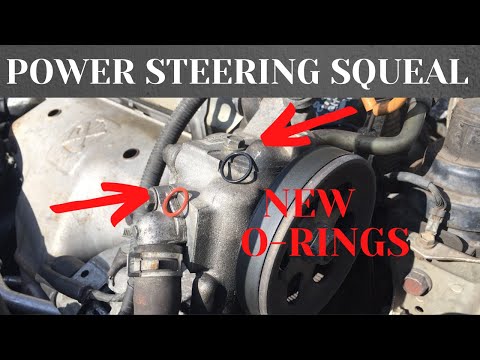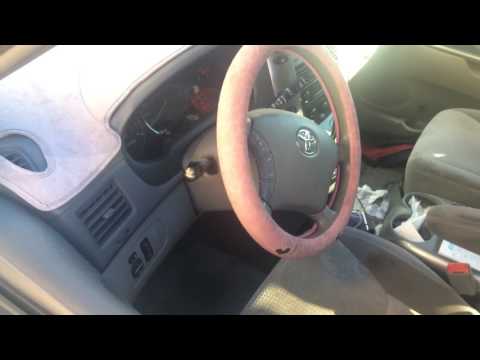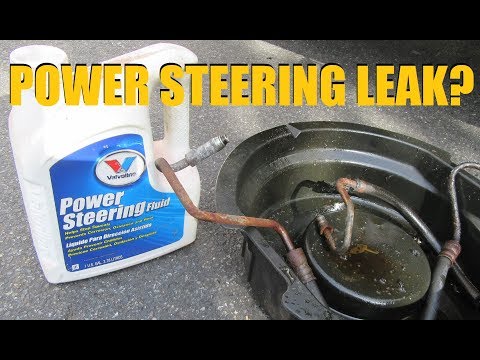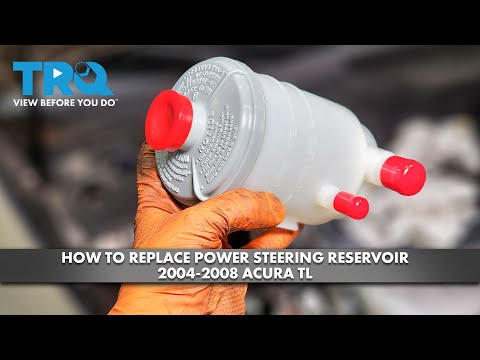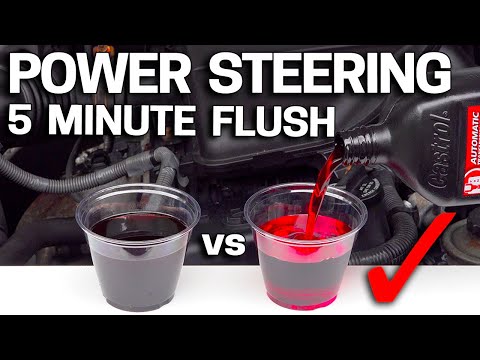
When your car starts to handle like a shopping cart, and the steering feels increasingly stiff, your first inclination should be to check the power steering fluid. You pop the hood to give it a look, only to see strange bubbles in the power steering reservoir.
This is a sign that an air leak or some other fault affects the lines in your power steering system. This is a big problem when you consider that power steering systems are hydraulic, and the lines out to the power steering control valve at the steering gear and then back to the reservoir are sealed. So, you need to find the source of the air coming in before the hydraulic components are damaged.
The most likely faults causing bubbles in your power steering fluid can be traced back to a leak in the low-pressure line or a crack in the fluid reservoir itself. However, it’s also possible for there to be a leak in the power steering pump, which is sucking air directly into the system with every cycle.
What Happens If There Are Bubbles in the Power Steering Fluid?
Once air gets into your car’s power steering system, it inevitably finds its way to the pump, where the internal impeller that drives the fluid essentially whips the air into the fluid. This creates a sort of bubbly, frothy hydraulic fluid that is no longer incompressible. The system rapidly loses the ability to transmit the necessary force to operate smoothly.
You notice this in the steering feels heavy and unresponsive. The effect worsens and is most noticeable when you have to make sharp turns at low speeds.
What Causes Your Power Steering Fluid Bubbling?
The most likely reason why your power steering fluid is bubbling is either a leak in the low-pressure return line or a crack somewhere in the power steering reservoir. However, there are other ways that air can get into the system. Even if you flush all the fluid and replace it, you’ll still need to find where the leak is coming from to keep bubbles from redeveloping again.
1. A Leak in the Power Steering Low-Pressure Return Line
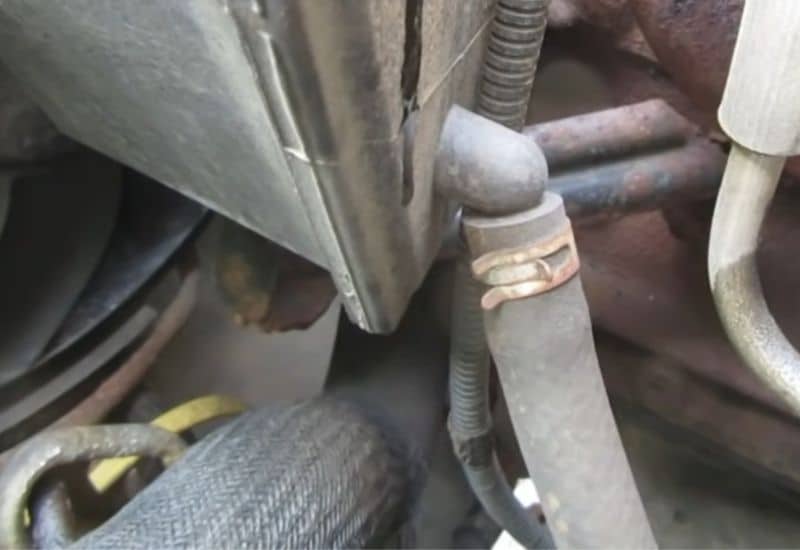
The power steering return line isn’t always as robust as the high-pressure side and can crack, letting air into the system and causing bubbles to appear in the reservoir. The hose is usually made from NBR tubing (Nitrile Butyl Rubber), which has superior resistance to petroleum products. When it’s new, it can handle pressure up to 150 PSI. Though NBR can get stiff and brittle with age, allowing tiny cracks to form, which could let in air.
As the power steering fluid moves back from the rack or steering gear through the low-pressure line, it gradually returns to normal atmospheric pressure. This allows the air bubbles to expand, making the fluid look frothy.
Usually, when the low-pressure power steering return line starts to leak, fluid goes out as air comes in. If you follow the line with your hand, you’ll eventually find a leak with tiny drips of power steering. If the power steering fluid lands on something hot, it will smoke, giving off a strange burnt smell like burned marshmallows.
2. A Leak in the Power Steering Pump
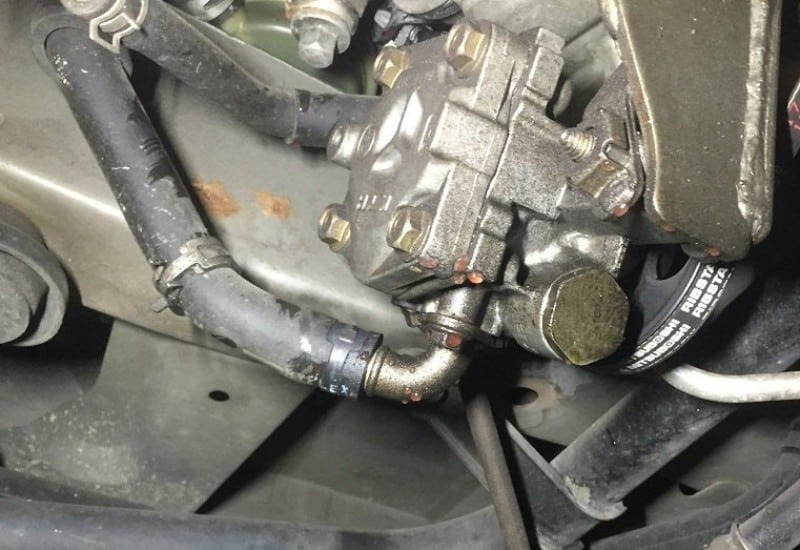
A leak in the power steering pump is another common way air can get into the system, causing bubbles in your power steering fluid. Here again, the air gets in and circulates through the system, gradually mixing into a froth that makes the steering stiff and unresponsive.
A significant volume of air could rush in depending on where the leak occurs. The most common point of failure is at the junctions where the hose transitions to the hard line. However, it’s also possible for the pump’s housing to crack.
A leak in the power steering pump is usually obvious, as pressurized fluid will spray out of the pump. It’s usually right under the reservoir, though some cars have the pump and reservoir separately.
Other signs of a leak in the power steering pump causing bubbles in the fluid include a whining noise when you first turn the car on and steering that gets stiff in a hurry. This is usually a sign that a major leak is letting fluid out and air in.
In some newer models, a severe leak might trigger a check engine or power steering light. When it does, the ECU will also throw a code you can check on an OBD II reader.
Code P0551 is for “Power Steering Pressure Sensor Circuit Range/Performance.”
3. A Crack in the Fluid Reservoir
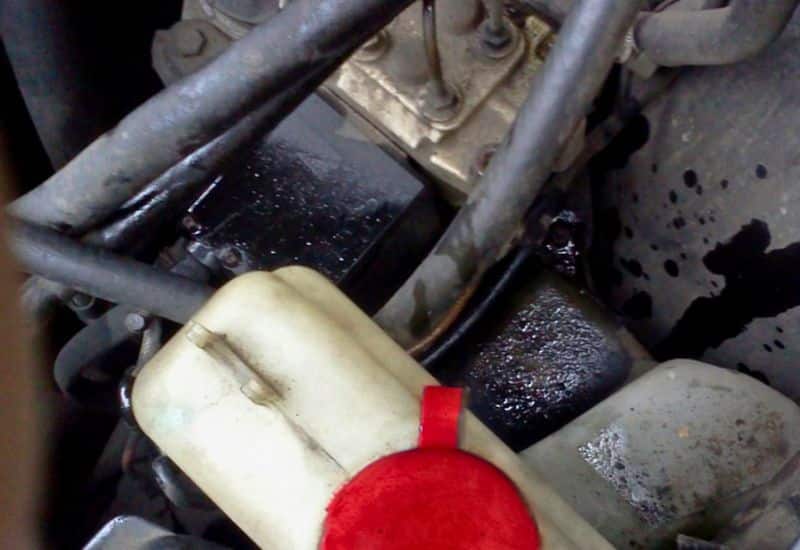
The plastic of the power steering fluid reservoir can crack or suffer a puncture that allows air into the system, causing bubbles. In a case like this, the leak is usually low down in the reservoir, allowing tiny gasps of air to be sucked in by the high-pressure line of the power steering pump.
When this happens, you’ll notice the bubbles in the power steering reservoir, and if you pull one of the lines, the fluid that comes out will be frothy. The bubbles will settle if you let the car sit with the engine off for an hour or two. At that point, the fluid level in the reservoir will be very low. You might even be able to spot a hairline crack in the white semi-translucent plastic.
4. The O-Ring on the Power Steering Input or Output
The power steering input and output lines have O-rings that can slowly fail, allowing small amounts of air into the system and creating bubbles in the power steering fluid. If it’s the output O-ring, the pressure of the fluid will let some fluid escape, and you’ll see it leaking on the power steering pump.
Though if it’s the input O-ring, air can seep into the system, and the low-pressure/atmospheric pressure might not make the leak obvious. At least not until the O-ring completely failed. At that point, you would have a noticeable fluid leak drizzling down into the engine bay.
5. A Bad Hose Clamp on the Return Line
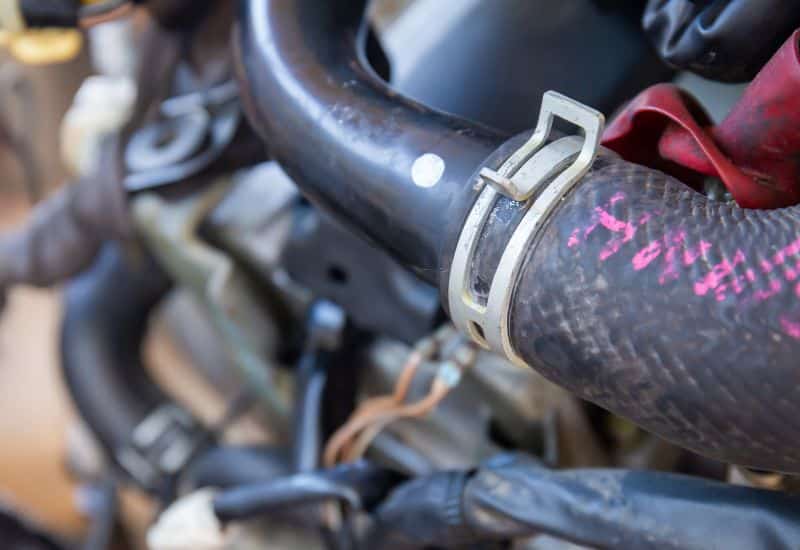
The low-pressure return line usually has a hose clamp that secures it to the reservoir/power steering pump. If the clamp had come loose or got bumped when you were working on something else, it could let a tiny amount of air into the reservoir, making little bubbles. These bubbles could gradually get sucked into the high-pressure side of the system, making the steering increasingly stiff just a little bit at a time.
This is a problem that is often slowly developing. You might not notice a major change in the car’s steering at first as the pump is inclined to draw in fluid from the bottom of the reservoir, and the small bubbles are inclined to float to the top.
As the volume of air suspended in the fluid steadily increases, more bubbles are drawn in, causing the power steering to become progressively stiff. By the time you notice it, the problem looks more serious than it did initially.
6. Improper Bleeding
If you’ve recently performed a DIY power steering fluid change but accidentally let some air in the system, it could show up as bubbles in the reservoir and the lines. In a case like this, a stray air bubble from improper bleeding passes through the power steering pump’s impeller, where it is whipped up into a froth that keeps circulating through the system.
Assuming it was a minor air bubble in the system, the amount of froth would be small. Yet it would also pervade the system, causing the steering to feel stiff. You’d notice the stiffness most when you turn the wheel on a sharp corner to lock at low speed. You might even get a high-pitched whine from the power steering pump itself.
How Do I Know If I Have Air in My Power Steering?
The most obvious sign of air in your power steering is bubbles or frothiness in the fluid reservoir. Usually, it’s the increasingly stiff steering, whining noises, and difficulty turning sharp corners at low speeds that cue most people into a power steering system problem. You might also notice a whining sound as the power steering pump struggles to maintain enough pressure or the steering gear struggles to meet the demand placed on it.
How to Find an Air Leak in Power Steering
One of the biggest challenges with air getting into your power steering and causing bubbles is finding where the leak is. Sure, a major leak that lets a lot of fluid pour out, or a leak in the high-pressure lines is easy and obvious to find.
Though these major faults tend to pop up quickly, you notice something is hideously wrong with your power steering. You pull over, pop the hood, and power steering fluid pukes everywhere with bubbles in the reservoir.
Though more often than not, the air leak is small, subtle, and somewhere in the low-pressure side of the power steering system. With these, air can get sucked into the system at a tiny point of failure, like a bad O-ring or a loose hose clamp, without power steering fluid managing to escape.
Suppose your car has the power steering fluid reservoir separated from the power steering pump. In that case, you can test the low-pressure line using a radiator pressure tester, a stopper the size of the hold in your reservoir cap, and the flowing steps.
If there are bubbles instead of frothiness, your leak might very well be in the low-pressure line from the rack, steering gear, and reservoir. If the power steering fluid is frothy, it means the air has been propagating through the system.
With only a few PSI, you should be able to see the leak in a hose, clamp, or the input O-ring. You will likely also be able to see a leak or crack in the plastic of the reservoir.
How To Eliminate Power Steering Fluid Air Bubbles?
Eliminating the bubbles in your power steering fluid starts with identifying and repairing the leak. Then, you can purge the system to get all the affected fluid out and refill it.
Fixing a Leak in the High-Pressure Power Steering Line
If the problem is a leak in the high-pressure line leading from the power steering pump to the rack or steering gear, the entire line must be replaced. In theory, you can do this yourself, which should take two to three hours.
This can be a little tricky in some models as the line might snake through the engine bay, and you don’t want to jerk it out once disconnected. The temptation is to simply run a new line, connect it to the pump and rack, and leave the old line in place. However, this will create major problems later on. Especially if an end of the line rattles over and makes contact with the serpentine belt, many people choose to have a mechanic replace the high-pressure line with an air leak.
The cost of a new high-pressure power steering line ranges from $50 to $110. If you change it yourself, it will take two to three hours. However, getting the old line out might be the most challenging part of the job!
If you take it to a mechanic, the labor cost will add another $125 to $225 to the final repair bill.
Replacing a Leak in a Low-Pressure Power Steering Line
A leak on the low-pressure line is arguably even tougher to replace as the line tends to snake through the lower regions of the car. If you have the patience, you can replace a low-pressure line in three to four hours, depending on the model.
The cost of a new NBR line can range from $25 to $75. However, paying a little extra for the CR-coated line is a good idea, which will protect against future leaks.
If you have a mechanic replace the line, the labor costs can add another $125 to $225 to the repair bill.
Replacing the Power Steering Reservoir
If a crack or puncture in your power steering reservoir is causing bubbles in your power steering fluid, you can replace the reservoir yourself to save you labor costs. Assuming your lines, O-rings, and clamps are all still good, you can replace your power steering reservoir with some basic tools and the following steps.
How To Replace Your Power Steering Fluid
Once you’ve made any necessary repairs to prevent air leaks from causing bubbles in the power steering fluid, you’ll need to replace the old fluid. This can be done with some basic tools, a vacuum pump, and a drip pan like you would use to change your oil.
Frequently Asked Questions
Is My Power Steering Fluid Boiling?
Hydraulic power steering fluid has a boiling point of around 575 to 600 degrees Fahrenheit. For your engine bay to get this hot, you’d have some serious other problems going on. So, if you’re seeing bubbles in your power steering fluid, it likely means that air is getting into the system or some other type of contamination is affecting the chemistry of the fluid itself.
Is Power Steering Fluid Flammable?
Technically, the power steering fluid is combustible but not flammable. If it drops on something hot, it will smolder, but it won’t immediately catch on fire of its own accord. However, it could cause damage to wires and hoses, which could then light on fire. So, if you have bubbles in your power steering fluid from a leak, there is a low but potential risk for a fire. However, the bigger issue would likely be the fumes, smoke, and off-putting aroma of burning marshmallows from the power steering fluid leaking onto something hot in the engine bay.
How Much Does It Cost To Repair Power Steering Fluid Bubbling?
Repairing the air leak that’s causing the bubbling or frothing power steering fluid can be as cheap as a DIY low-pressure hose replacement, costing less than $50. It could also be as expensive as replacing the power steering pump over $350 to $400.
Most of the time, it’s a bad hose with a crack in it or a failing hose clamp that’s letting in a little air. These are usually cheap fixes that you can do yourself for less than $100. A mechanic’s labor time could add another $150 to $200.
Can I Drive When My Power Steering Has Air In It?
If it’s just a little air from a small leak in an O-ring, you might be able to get away with the stiff steering for a while. However, the problem will only worsen, and the handling might be dangerously unmanageable.
You also risk placing undue stress on the pump and other system components, which could lead to premature failure. The wise move is to fix the leak quickly and replace all the power steering fluid.
How Long Does It Take To Remove The Air From A Power Steering System?
The easiest and most effective way to remove air from the power steering fluid is to replace all the old fluid completely. You can do this in under an hour with a vacuum pump and some simple tools. Just be sure to fix whatever air leak caused the problem first, or you’ll return to square one in no time.
What if I Don’t Bleed My Power Steering?
If you don’t bleed your power steering fluid and simply drive with air leaking into the system, the bubbles will increase stress on the power steering pump and potentially the rack or steering gear. In time, you’ll start to hear the power steering pump make a high-pitched whine as the motor and internal impeller start to fail.
Conclusion
Frothiness or bubbles in your power steering fluid is almost always caused by air in the system. This could be a leak in one of the hoses, a failure in an O-ring, or a tiny crack in the power steering fluid reservoir.
If the leak is on the high-pressure side of the power steering system, you’ll notice it quickly. Something will give in to the hose or a connection; your steering will feel instantly hard and quickly get worse. This usually requires a mechanic to replace the line and ensure everything on the system’s high-pressure side is operating properly.
If it’s an air leak on the low-pressure side or the power steering fluid return line, the bubbles in the fluid can slowly build up over time. This can cause the steering to feel slightly stiffer over several days before you notice enough to check the fluid.
The easiest way to ferret out the leak is to put a pressure tester on the power steering reservoir’s fill port. Apply a few PSI of pressure, and the leak will spew out power steering fluid. If it is the low-pressure return line, a pipe clamp, or an O-ring, you should be able to repair it yourself for less than $100 and an hour or two of your time.
Once the air leak is fixed, the wise move is to pump or drain out the power steering fluid and replace it with fresh fluid. This spares you the worry of bubbles or froth still being stuck somewhere in the system, waiting to wreak havoc once again.

Written By
Jason Farrell
Jason Farrell is a certified master technician, the editor of Mechanic’s Diary in Pittsburgh, Pennsylvania. He is ASE (Automotive Service Excellence) certified and earned a Bachelor’s Degree in Automotive Technology from Pittsburg State University. With nearly 18 prior years of experience in the automotive field, he has extensive knowledge about Domestic, European, and other foreign makes and models of cars and light trucks. Jason’s experience working as a technician and service manager at dealerships, gave him the experience and know-how of most aspects of inspection, diagnosis, and repair from engine and drivability to electrical, HVAC, brakes, steering and suspension and everything in between.

